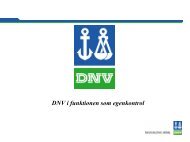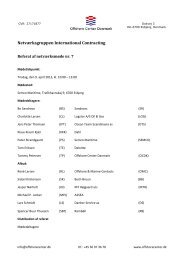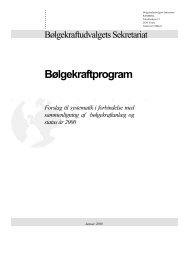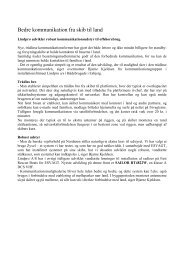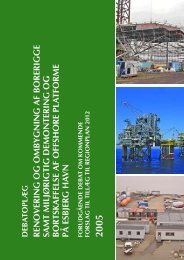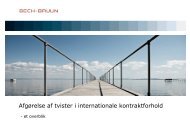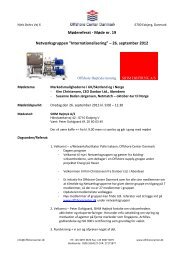Create successful ePaper yourself
Turn your PDF publications into a flip-book with our unique Google optimized e-Paper software.
Design of Access Platforms<br />
for <strong>Offshore</strong> Windturbines<br />
By Thomas Lykke Andersen &<br />
Peter Frigaard, Aalborg University<br />
A large number of offshore windfarms have<br />
been constructed, more are currently under<br />
construction and many more are planned.<br />
Therefore, a lot of research is going on<br />
within the design of offshore windfarms and<br />
their foundation.<br />
Aalborg University has lately investigated<br />
the wave run-up on a circular cylinder and<br />
the forces that the run-up generates on a<br />
horizontal platform and a conical platform<br />
using model tests. The tests have been carried<br />
out for D<strong>ON</strong>G Energy as a part of the<br />
design of the foundations for the planned<br />
Horns Rev II windmill farm.<br />
The background for the study is the observations<br />
from the Horns Rev I windmill<br />
farm, where the wave run-up height has<br />
been shown to be significantly larger than<br />
accounted for in the design. This has led to<br />
damage to some of the access platforms and<br />
boatlanding facilities. The logical approach<br />
might seem to be to place the platforms<br />
significantly higher, but for safety reasons<br />
this is not possible.<br />
The objective for the model tests was to<br />
establish a design procedure to determine<br />
the impact pressures on the platforms, in the<br />
following three step procedure:<br />
1) Calculate the expected maximum wave<br />
run-up height with no platform.<br />
2) Use this run-up height to calculate the<br />
velocity at the level of the platform.<br />
3) Use a slamming force model to get the<br />
maximum pressures.<br />
Wave run-up has been measured in a small<br />
scale model using five water level gauges<br />
attached to the surface of the pile, cf. Fig.<br />
1. The gauges were placed 2 mm from the<br />
surface of the pile and catch the green water<br />
run-up, but not spray which is mainly gener-<br />
Measurement of waverun-up on pile.<br />
Fig. 2: Measurement of impact pressures for horizontal platform.<br />
Fig. 3: Measurement of impact pressures for conical platform.<br />
ated by breaking waves. These tests have<br />
been performed to calibrate step 1 and 2 in<br />
the design procedure.<br />
Access platforms are typically horizontal,<br />
but the client comes up with a conical platform<br />
solution, as they expected significantly<br />
smaller slamming forces for this structure.<br />
Therefore, both a horizontal platform and<br />
a conical platform were considered in step<br />
3 of the design procedure. The slamming<br />
forces generated were measured by pressure<br />
cells as shown in Fig. 2 & 3.<br />
<strong>Offshore</strong> <strong>Center</strong> Denmark<br />
Newsletter <strong>ON</strong>/<strong>OFF</strong> 10 - May 2007<br />
13



